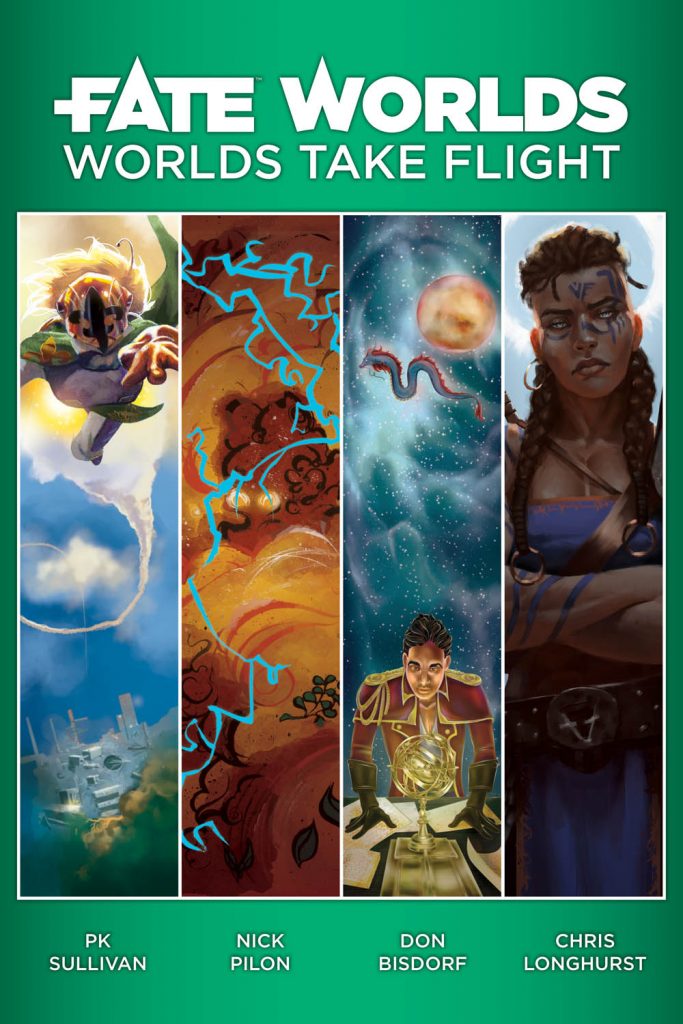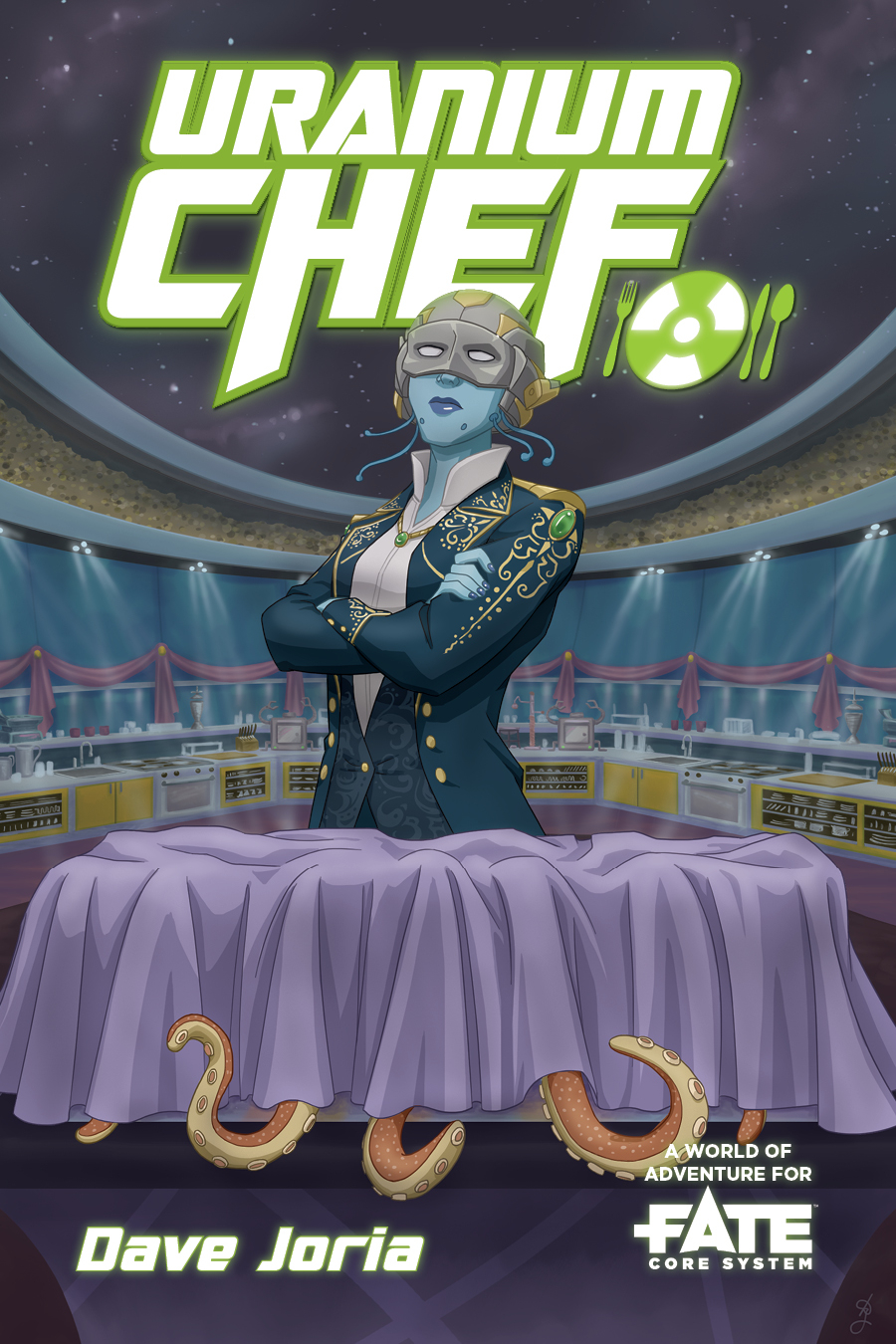Hello, Tangerine! It’s been a while! One of my favorite card games for the last few years has been Channel A, the anime pitch game. If you don’t know it, it starts off similar to Apples to Apples: the judge sets two cards for the genre, and each player picks up to five cards for the title.
However, where it deviates is what comes next: players then have to pitch a new anime series using that title. They give a quick 10-30 second pitch about the characters, the plot, the twists, the toys; anything to put their story ahead.
I’ve talked with Ewen about how it might be the fun basis for an RPG; imagine, using these cards to create an RPG setting in minutes. Or, better still, why not a whole multiverse of connected anime settings??

CHANNEL A – Fan RPG
RPG adaptation by Dave Seidman-Joria
Based on the Card Game by Ewen Cluney – For sale at Evil Hat’s website!
Note: This is a fan creation, and is in no way affiliated with or authorized by Evil Hat. Not for sale.
EDIT: I completely forgot that you can also buy Channel A for Roll20; which is a PERFECT way to segway from game to RPG!
SET-UP
The players should play 2 quick games of Channel; After determining the winning Pitch in round one, set aside the winning title, genre, and all other cards used that round. Play a second game; afterwards, set these cards aside too. All these cards (including unused cards in hand) are called the BOARD.
Players decide amongst themselves which of the two winning pitches they want to use as the foundation for their RPG game and which player is going to be the GM. If there is a tie, the GM gets the tiebreaker vote. The basic pitch should serve as a basis for the story, with players creating new characters to populate it. The winning title cards used in the winning pitch become the TITLE, while the genre cards become the GENRE.
BUILDING CHARACTERS
Each player has 6 character points, which they can distribute between 3 to 5 different stats.
The stats you can use are chosen from:
- Any number of cards from in the title (Ex. If the title is “Fullmetal Honey Panic Heroes,” skills you can access are Fullmetal, Honey, Panic, and Heroes.)
- Up to ONE cards from the GENRE (ex. If the Genre is Boys Love and Military, you could pick Boys Love OR Military but not both.
- Up to ONE leftover card from anywhere on the BOARD (including cards from the other game). Players are discouraged from using the same leftover card another player is using
Exceptions and Clarifications
- Limits: No single stat can start higher than 3
- Players aren’t required to spend all their points at set-up; they may save points to create skills mid-game.
- The GM may allow players to pick a 2nd leftover card for the basic of a stats; this is recommended for titles with fewer than 4 words (or if a player just has a really fun idea that fits the setting); it is also recommended Genre-shift campaigns (see below).
- If a title card is particularly vague, the GM may require a player specify what it means to THEIR character in some way. (Ex. 2 players pick the title card “Z”; one player picks it to mean “Zebra” because she has zebra DNA, and the other player has it stand for “Zephyr” for having wind magic.)
Sample Build
The Genre was Sports & Steampunk
The Winning title was “Infinite Witches Fury Ring.”
The story is about witches using their magic to power mech suits to fight in colossal wrestling matches.
Two player characters are Genna and Moxie
Genna
| Witches | +3 |
| Steampunk | +2 |
| Queen (Leftover) | +1 |
Moxie
| Sports | +2 |
| Fury | +2 |
| Sailor (Leftover) | +1 |
| Infinite* | +1 |
*When asked to explain “Infinite,” Moxie’s player explains that Moxie never gives up; not in sports, life, or anything.
ACTIONS
Actions use a simplified version of the Forged in the Dark system. When you take an action, roll 1d6 for each point of the stat, and pick the highest result.
6 – Full Success – You gain what you attempted (multiple 6s grant additional boost)
4-5 – Partial Success – You gain part of what you want, or succeed at a cost.
1-3 – Bad Outcome – You fail, or succeed at an extreme cost.
If your skill is 0, you roll two dice, and a pick the lower.
The GM may decide that doing something particularly easy or difficult will change the number of dice you roll (increasing or decreasing)
Opposed Action
If you are opposed, the GM also rolls one or more dice for their action, to represent the opposition. The higher roll gets the result marked above; the lower roll is treated as “bad outcome.” If tied, any side that rolled doubles breaks ties. If no tie breaker, treat as partial success for both.
Actions – Alternative
Don’t like the Blades Approach? Why not make use Fate Core, and roll 4dF? Or, simply roll a single 1d6 and add the skill as a bonus?
Campaigns
If running multiple games in the same setting, after each successful adventure, a player may increase one of their stats by +1 (provided it doesn’t go above 3). If they have less than five skills, they can also get +1 in a new stat.
Genre-Spanning Campaign
Channel A RPG is best set up as a dimension spanning; after every story or every session, the characters are sent to another world.
Concept –
>Guardians of the Multiverse, keeping different worlds safe.
>Dimensional sliders, unable to return home.
>Video gamers, reincarnated into an Isekai video game
Alt Set-up – A genre-spanning campaign, PCs should set at least TWO stats using leftover cards from the board.
Shifting Worlds – When it is time to shift to a new world, the players should pick two new genre cards. Then, instead of creating a brand new title from scratch, players should draw new cards, and create a new title that uses both cards in their hand and one or Title card from the last world (think of a it like Texas Hold-Em, with a communal pot of title cards the player should use as a basis).
Shifting points – When going to the new world, each player may shift up to 2 Title skills from the old Title to new title.
Shifting Genre skills are a little harder – once they move to a new world, any character with a genre skill rolls 1d6:
1-2 – Lost – You lost the skill, and have nothing to replace it at this time. Instead, keep track of how many points you lost; when you go through an epiphany (see below), you get a new skill with that many stat points.
3-4 – Stubborn – Defying all genres, you seem to have kept the genre skill from the LAST world into this one. This means, you might be a Militaristic genius in a maid café world! When you go through an epiphany, you have the option of changing to a new skill.
5-6 Flexible – You have a choice: Immediately shift your skill to a new genre card for this setting, or pick a new discarded title card to serve as a new skill.
Epiphany – PCs gain an epiphany when they undergo something that makes them reassess themselves or their settings. Common influences might include: failing on an important roll and suffering the consequences; remembering what’s important to; being backed into a corner. You can also tie-in genre appropriate tropes for the epiphany: ex. Falling in love for a romance; meeting being beaten in the first-half of a sports anime; combining into a giant megazord in a mech anime.
Advancement and Shifting – If a story is completed, PCs shift worlds and skills, and THEN gain +1 skill point for advancing. This will let them reprioritize their focus, or gain new skills.
Sample Shift
The setting has shifted from Sports & Steampunk “Infinite Witches Fury Ring.”
New setting: Post Apocalyptic Spy-Thriller.
The final match was interpreted by a demonic entity that the was only defeated with teamwork. However, the banish it to the Netherworld resulted in a second portal opening, sending Genna and transferred to a new world.
The setting: a scored world where the last remaining nations are scrambling to find the last remaining plot of fertile land; known only in rumors as Midori. The name has shifted to, “Witches Ring 2nd Stage Midori.”
Two player characters are Genna and Moxie try to quickly acclimate to their new desolate, high-tech world.
Genna’s stats WERE:
| Witches | +3 |
| Steampunk | +2 |
| Queen (Leftover) | +1 |
However, “Steampunk” genre no longer applies here. She rolls a 1; she has trouble adapting, and is stuck with 2 points that she can’t use until she has an epiphany. She also gains +1 point advanced from the last session. She decides to gain a new skill: she picks the card Comic, to show that Genna’s wit is and charisma is getting sharper.
| Witches | +3 |
| Queen (Leftover) | +2 |
| Comic (Leftover) | +1 |
| ? ? ? | +2 |
Moxie’s stats were
| Sports | +2 |
| Fury | +2 |
| Sailor (Leftover) | +1 |
| Infinite* | +1 |
She rolled on the genre ability Sports and got “Stubborn” – she keeps the skill Sports, despite the shift. She chooses to move the Infinite +1 to Ring +1, to show that Moxie’s quickly adapting to being in a close-knit spy ring. She adds +1 to Fury, bringing it to +3
| Fury | +3 |
| Sports | +2 |
| Sailor (Leftover) | +1 |
| Ring | +1 |
LAST VARIATION – THE GATHERING
As an alternative to having your characters travel from world to world, why not skip straight to the mash-up?
Set-Up: Each player draws two genre cards and a title that serves as the foundation for their own character. Then, the GM creates one extra world that all of these characters are pulled into. Is it a celestial nexus with a cosmic threat or a tournament of the gods? Do they break the fourth wall and appear in the real world?
It might seem strange that the humble student /doujinshi artist is teaming up with a cyborg monster hunter and a fanservice-plagued sentai hero, but they will no doubt find a way to combine their talents and save the day!
That’s all for this post. All of us at Tangent Artists wish you a Happy Thanksgiving, and game on!
-Dave Seidman-Joria






 Creators: Writer: Rob Wieland. Editor: Joshua Yearsley. Art: Brian Patterson.
Creators: Writer: Rob Wieland. Editor: Joshua Yearsley. Art: Brian Patterson.









 Dungeon Tours Limited
Dungeon Tours Limited I am pleased to announce that this week, my setting, “Uranium Chef,” has been released through Evil Hat’s Worlds of Adventure Patreon. You can buy it here (pay-what-you-want) at
I am pleased to announce that this week, my setting, “Uranium Chef,” has been released through Evil Hat’s Worlds of Adventure Patreon. You can buy it here (pay-what-you-want) at